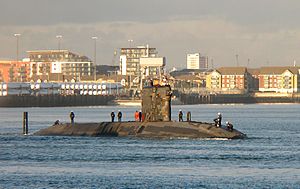 HMS Trafalgar in 2008
| |
| Class overview | |
|---|---|
| Builders | Vickers Shipbuilding and Engineering, Barrow-in-Furness |
| Operators | |
| Preceded by | Swiftsure class |
| Succeeded by | Astute class |
| Cost | £200 million (1986) per unit |
| Built | 1977–1986 |
| In service | 1983–present |
| Completed | 7 |
| Active | 1 |
| Retired | 6 |
| General characteristics [1] | |
| Type | Nuclear-powered fleet submarines |
| Displacement | |
| Length | 85.4 m (280 ft)[2] |
| Beam | 9.8 m (32 ft)[2] |
| Draught | 9.5 m (31 ft)[2] |
| Propulsion |
|
| Speed | Over 30 knots (56 km/h), submerged[2] |
| Range | Unlimited[2] |
| Test depth | 600m |
| Complement | 130[2] |
| Electronic warfare & decoys |
|
| Armament | |
The Trafalgar class is a class of nuclear-powered fleet submarines (SSNs) in service with the Royal Navy, and the successor to the Swiftsure class. Like the majority of Royal Navy nuclear submarines, all seven boats were constructed at Barrow-in-Furness shipyard, Cumbria. With only one boat remaining active and in commission (as of 2023) and six retired from the seven originally in service, the class makes up part of the Royal Navy's nuclear-powered ‘hunter-killer’ submarine force. The Trafalgar class has nearly been replaced by the larger and more capable Astute class, of which five are commissioned.
The name Trafalgar refers to the Battle of Trafalgar fought between the Royal Navy and the combined fleets of France and Spain in 1805.
- ^ "Trafalgar Class – Royal Navy". Retrieved 19 December 2014.
- ^ a b c d e f g h Bush, Steve (2014). British Warships and Auxiliaries. Maritime Books. p. 12. ISBN 978-1904459552.
- ^ Graham, Ian, Attack Submarine, Gloucester Publishing, Oct 1989, page 12. ISBN 978-0-531-17156-1
Cite error: There are <ref group=Note> tags on this page, but the references will not show without a {{reflist|group=Note}} template (see the help page).